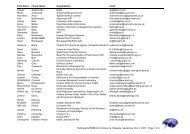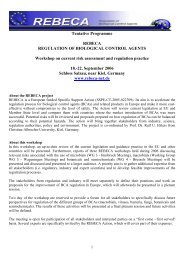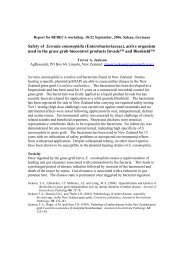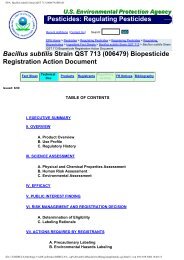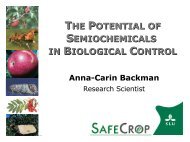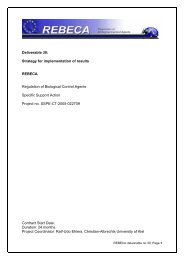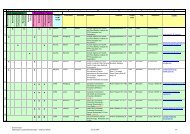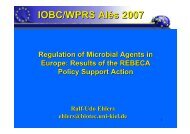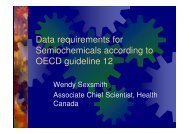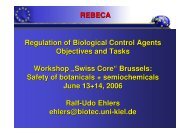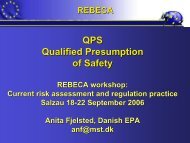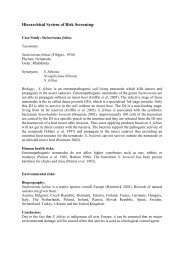Deliverable 28: Specification of low risk products REBECA ...
Deliverable 28: Specification of low risk products REBECA ...
Deliverable 28: Specification of low risk products REBECA ...
You also want an ePaper? Increase the reach of your titles
YUMPU automatically turns print PDFs into web optimized ePapers that Google loves.
Bacteria directly consumed by humans only qualify for QPS status, if they are free <strong>of</strong><br />
acquired resistance to antibiotics <strong>of</strong> importance in clinical and veterinary medicine.<br />
Furthermore, all bacteria capable <strong>of</strong> toxin production should be demonstrated to be<br />
free <strong>of</strong> any toxigenic potential.<br />
It is important to stress that QPS does not carry any legal status.<br />
Since neither B. thuringiensis nor any <strong>of</strong> the filamentous fungi are included on the list<br />
<strong>of</strong> species proposed for QPS status, the QPS in its present form does not <strong>of</strong>fer a<br />
generic approach to the safety assessment <strong>of</strong> most micro-organisms used as<br />
biological control agents. Never the less, the EFSA Scientific Committee considers<br />
that it may be possible to devise robust use qualifications which would al<strong>low</strong> a QPS<br />
approach for further groups <strong>of</strong> micro-organisms relevant for biological control in the<br />
future. The system is developed in order to provide a generic assessment system for<br />
use within EFSA that can be applied to all requests for the safety assessment <strong>of</strong><br />
micro-organisms deliberately introduced into the food chain or used as producer<br />
strains for food/feed additives. This implies, that when industry applies for Annex I<br />
inclusion <strong>of</strong> micro-organisms belonging to microbial taxonomic units, which are now<br />
included in the list <strong>of</strong> organisms for which a QPS status is proposed (e.g. Bacillus<br />
subtilis and B. pumilus) with the intention to market these in plant protection<br />
<strong>products</strong>, the industry can in their dossier argue that the species are given QPS<br />
status, and that the <strong>risk</strong> for consumer health (due to exposure from residues on<br />
crops) is likely to be <strong>low</strong> when these strains are applied as plant protection <strong>products</strong>.<br />
This information can be used as a waiver for residue data for micro-organisms given<br />
QPS status. The list <strong>of</strong> taxonomic units for which QPS status has been proposed can<br />
be found in Annex 1.<br />
The applicability <strong>of</strong> the QPS approach for broad use <strong>of</strong> micro-organisms as plant<br />
protection <strong>products</strong> needs to be discussed further.<br />
USA: Minimal Risk Pesticides (25b list)<br />
In the USA, there is a list <strong>of</strong> substances that can be used as pesticides without any<br />
registration, however, they still need a residue limit, or exemption, for food or feed<br />
uses. These substances are called Minimal Risk Pesticides, as described in the US<br />
Code <strong>of</strong> Federal Regulation, 40CFR 152.25(f). The list contains many essential oils 1 .<br />
All inerts must be on EPA’s 4A inert list, all ingredients must be identified on the<br />
label, and the label may not contain false or misleading claims. This regulation was<br />
developed by an EPA workgroup in 1994 and revised in accordance with public<br />
comments for a final Federal Register publication in 1996. The EPA has experienced<br />
a problem since it has been difficult identifying exactly which chemical substances<br />
are included under the names listed. Currently, CAS numbers are used to describe<br />
the substances on the EPA inert substance classification lists.<br />
1 Currently, the list includes the fol<strong>low</strong>ing substances: castor oil, cedar oil, cinnamon and cinnamon oil,<br />
citric acid, citronella and citronella oil, cloves and clove oil, corn gluten meal, corn oil, cottonseed oil,<br />
dried blood, eugenol, garlic and garlic oil, geraniol, gernanium oil, lauryl sulfate, lemongrass oil,<br />
linseed oil, malic acid, mint and mint oil, peppermint and peppermint oil, 2-phenethyl propionate (2-<br />
phenylethyl propionate), potassium sorbate, putrescent whole egg solids, rosemary and rosemary oil,<br />
sesame (includes ground sesame, plant) and sesame oil, sodium chloride (common salt), sodium<br />
lauryl sulfate, soybean oil, thyme and thyme oil, white pepper and zinc metal strips.<br />
8



